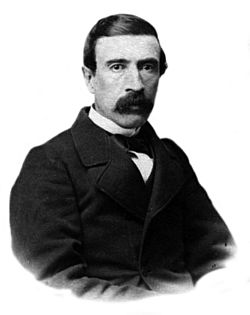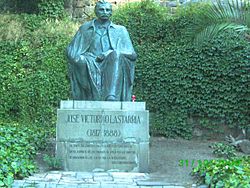José Victorino Lastarria facts for kids
Quick facts for kids
José Victorino Lastarria
|
|
|---|---|
 |
|
| Minister of Finance | |
| In office 1862–1863 |
|
| Preceded by | Manuel Rengifo |
| Succeeded by | Domingo Santa María |
| Personal details | |
| Born | 23 March 1817 Rancagua, Chile |
| Died | 14 June 1888 (aged 71) Santiago, Chile |
| Political party | Liberal |
| Spouse | Julia Jesús Villarreal |
| Children | Victorino Aurelio Lastarria, 11 others |
| Parents |
|
| Residences | Santiago, Chile |
| Alma mater | University of San Felipe |
| Profession | Attorney, writer |
| Signature | |
José Victorino Lastarria (born March 23, 1817 – died June 14, 1888) was an important Chilean writer, politician, and diplomat. He served in many roles, including as a lawmaker, senator, and even as the Minister of Finance for Chile.
Early Life and Education
José Victorino Lastarria was the son of Francisco Lastarria y Cortés and Carmen Santander Bozo. He was born in Rancagua, Chile.
He first studied in his hometown. Later, he received a scholarship to move to Santiago and attend the Liceo de Chile. This school was run by José Joaquín de Mora. During this time, a civil war happened in Chile (1829–1830). The Liberals, called Pipiolos, lost to the Conservatives, known as Pelucones. His teacher, Mora, was forced to leave the country. This event made Lastarria want to fight against what he saw as an unfair government.
Lastarria married Julia Jesús Villarreal on June 8, 1839. They had 12 children together. One of their children was an engineer named Victorino Aurelio Lastarria.
Studies and Ideas
In 1834, Lastarria became a student of the famous scholar Andrés Bello. After finishing at the National Institute, he studied many subjects. He became a geographer and a lawyer in 1839. He earned these titles from the Royal University of San Felipe and the Institute of Law.
Lastarria and other students from the National Institute started the Literary Society of 1842. This group helped spread liberal ideas. These ideas were not allowed by the government of Manuel Bulnes at the time.
In 1843, Lastarria became one of the first professors at the University of Chile.
Political Journey
In 1848, the government became very strict. Lastarria joined a group called the Society of Equality. This group wanted to change the government and the Constitution of 1833. In 1850, he was arrested and sent to Lima, Peru.
He returned to Chile to take part in the 1851 Chilean Revolution. This revolution tried to stop Manuel Montt from becoming president. The government stopped the revolution, and Lastarria had to escape back to Peru. He was one of the "ten most wanted men in Chile."
Lastarria joined other Chileans who were living in exile. They sought international support against the Conservative government. Following advice from Francisco Bilbao, he returned to Chile in 1853. He settled in Valparaíso. There, he supported protests against the government. He also joined the Freemasons, a group that was not officially recognized in Chile back then.
In 1859, a popular uprising happened. This led to a shift towards a Liberal government. Lastarria became a key figure in this change. Between 1861 and 1871, during the time of President José Joaquín Pérez, Lastarria was very active. He was the dean of philosophy at the University of Chile. He was also appointed Minister of Finance. In this role, he tried to bring in new economic ideas. These ideas focused on how the economy could benefit society, but he didn't have much success.
In 1860, he wrote a notable fantasy novel called Don Guillermo. This book had a political message. It used Mapuche myths and legends to show the lack of freedom under the conservative governments. It was a short but powerful book. It brought him both fame and criticism during this time of political change.
In 1862, Lastarria went back to Lima, Peru, this time as an ambassador. In 1864, he was there during the Chincha Islands War. This war led Chile to declare war against Spain.

In early 1865, he traveled to Argentina. He led a diplomatic mission to form an alliance against Spain. He also negotiated about the ownership of Patagonia. Lastarria suggested a deal that would give Argentina almost all of this land. Chile would keep Tierra del Fuego and some nearby areas. However, when he returned to Chile, the government rejected the deal. Argentine authorities later used this to claim most of Patagonia. Lastarria believed Chile did not have a strong claim to these lands. He also wanted to avoid a war over them.
In 1876, President Aníbal Pinto appointed him Interior Minister. During this time, he created the Diario Oficial. This became Chile's official government newspaper.
In 1879, during the War of the Pacific, Lastarria was sent to Brazil. His mission was to make sure Brazil did not support Chile's enemies. He successfully completed this important task.
Lastarria also served as a judge in the Court of Appeals (1875) and the Supreme Court (1883). He was a deputy (a type of lawmaker) for several areas. He also became a member of the Royal Spanish Academy in 1870.
Tributes
Many places and institutions have been named in his honor. On June 1, 1913, the José Victorino Lastarria High School was opened in Santiago. This was done by President Ramón Barros Luco and University of Chile rector Domingo Amunátegui Solar.
Another school, the Liceo José Victorino Lastarria, was also established in his hometown of Rancagua.
See also
 In Spanish: José Victorino Lastarria para niños
In Spanish: José Victorino Lastarria para niños
- Francisco Bilbao
- Pedro Nolasco Cruz Vergara


